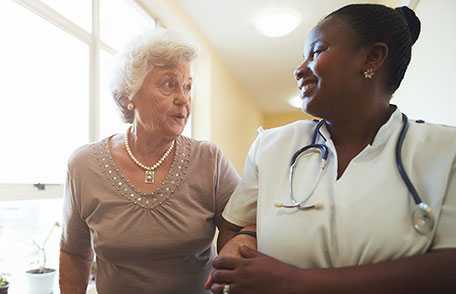How Cardiac Rehabilitation Can Help Heal Your Heart

If you have a heart attack or other heart problem, cardiac rehabilitation (rehab) is an important part of your recovery. Cardiac rehab can help prevent another, perhaps more serious, heart attack and can help you build heart-healthy habits. Learn more about who needs cardiac rehab and how it can help your recovery.
Nearly 800,000 people in the United States have a heart attack every year. About 1 in 4 of those people had already had a heart attack.1 Cardiac rehab not only can help a person recover from a heart problem, but it can also prevent another heart problem in the future.
What is cardiac rehab?
Cardiac rehab is an important program for anyone recovering from a heart attack, heart failure, or other heart problem that required surgery or medical care.
Cardiac rehab is a supervised program that includes:
- Physical activity.
- Education about healthy living, including healthy eating, taking medicine as prescribed, and ways to help you quit smoking.
- Counseling to find ways to relieve stress and improve mental health.
A team of people may help you through cardiac rehab, including your health care team, exercise and nutrition specialists, physical therapists, and counselors or mental health professionals.
Who needs cardiac rehab?
Anyone who has had a heart problem, such as a heart attack, heart failure, or heart surgery, can benefit from cardiac rehab. Studies have found that cardiac rehab helps men and women, people of all ages, and people with mild, moderate, and severe heart problems.2
But certain people are less likely to go to or finish a cardiac rehab program. These include:
- Women. Studies show that women, especially minority women, are less likely than men to go to or complete a cardiac rehab program.3,4,5 This may be because doctors may be less likely to suggest cardiac rehab to women.
- Older adults. Older adults are also less likely to join a cardiac rehab program following a heart problem.3,5 They may think they are unable to do the physical activity because of their age, or they may have other conditions that can make exercising harder, such as arthritis. This makes cardiac rehabilitation especially useful for older adults, since it can improve strength and mobility to help make daily tasks easier.5

One of the benefits of cardiac rehab is building healthier habits, such as finding a physical activity that you enjoy, to help you stay heart-healthy for life.
How does cardiac rehab help?
Cardiac rehab can have many benefits to your health in both the short and long-term, including:
- Strengthening your heart and body after a heart attack.
- Relieving symptoms of heart problems, such as chest pain.
- Building healthier habits, including getting more physical activity, quitting smoking, and eating a heart-healthy diet. A nutritionist or dietitian may work with you to help you limit foods with unhealthy fats and eat more fruits and vegetables that are high in vitamins, minerals, and fiber.
- Reducing stress.
- Improving your mood. People are more likely to feel depressed after a heart attack. Cardiac rehab can help prevent and lessen depression.6
- Increasing your energy and strength, making daily activities easier, such as carrying groceries and climbing stairs.
- Making you more likely to take your prescribed medicines that help lower your risk for future heart problems.7
- Preventing future heart problems and death. Studies have found that cardiac rehab decreases the chances you will die in the five years following a heart attack or bypass surgery by around 20% to 30%.2,3
Where can I get it?
Some programs are done in a hospital or rehabilitation center, while some programs can be done in the patient’s home. Cardiac rehab may start while you are still in the hospital or right after you leave the hospital.
Cardiac rehab programs usually last about three months but can range anywhere from two to eight months.
Talk to your doctor about a cardiac rehab program. Many insurance plans, including Medicaid and Medicare, cover it but require your doctor to provide a referral for the program.
More Information
References
- Benjamin EJ, Blaha MJ, Chive SE, et al. Heart disease and stroke statistics—2017 update: a report from the American Heart Association. Circulation. 2017;135:e146-e603. doi: 10.1161/CIR.0000000000000485.
- Schopfer DW, Forman DE. (2016). Benefits of cardiac rehabilitation in older adults. American College of Cardiology Web site.
- Suaya JA, Stason WB, Ades PA, Normand ST, Shepard DS. Cardiac rehabilitation and survival in older coronary patients. J Am Coll Cardiol. 2009;54:25-33. doi: 10.1016/j.jacc.2009.01.078.
- Oosenbrug E, Marinho RP, Zhang J, et al. Sex differences in cardiac rehabilitation adherence: a meta-analysis. Can J Cardiol . 2016; 32:1316-1324. doi: 10.1016/j.cjca.2016.01.036.
- Witt BJ, Jacobsen SJ, Weston SA, et al. Cardiac rehabilitation after myocardial infarction in the community. J Am Coll Cardiol. 2004;44:988-996. DOI: 10.1016/j.jacc.2004.05.062.
- Milani RV, Lavie CJ. Prevalence and effects of cardiac rehabilitation on depression in the elderly with coronary heart disease. Am J Cardiol. 1998;81:1233-1236.
- Shah ND, Dunlay SM, Ting HH, et al. Long-term Medication Adherence after Myocardial Infarction: experience of a community. Am J Med . 2009 Oct; 122(10): 961.e7–961.13. doi: 10.1016/j.amjmed.2008.12.021
- Page last reviewed: July 10, 2017
- Page last updated: July 10, 2017
- Content source:
- National Center for Chronic Disease Prevention and Health Promotion, Division for Heart Disease and Stroke Prevention
- Page maintained by: Office of the Associate Director for Communication, Digital Media Branch, Division of Public Affairs




 ShareCompartir
ShareCompartir